Snake & Crane Arts Of Shaolin (1978)
Directed by: Chen Chi Hwa
Written by: Hsin Yi Chang
Starring: Jackie Chan, Kong Kim, Nora Miao, Sheng Wang Chi
AKA SHE HE BA BU
AVAILABLE ON BLU-RAY: NOW, from 88 Films
RUNNING TIME: 96 mins
REVIEWED BY: Dr Lenera, Official HCF Critic
Hsu Ying Fung quickly makes it known that he possesses the “Eight Steps of the Snake and Crane”, a martial arts manual illustrating the ultimate fighting style. It was written by eight Shaolin masters, but shortly afterwards they all disappeared. He befriends street kid Hung Chu Hsu, but is continually attacked by other fighting clans who also want the book and who are willing to offer a variety of things for it, though some suspect him of being responsible for the masters’ disappearance, and he clearly knows more than he’s letting on, in particular with his interest in looking for some kind of skin mark on his opponents….
I can’t decide between this movie and the one that came before it – Shaolin Wooden Men from the same director – as my favourite of Jackie Chan’s Lo Wei produced films. I guess the former is better as an all-round piece of movie entertainment, but there’s no doubt that Snake & Crane Arts Of Shaolin, for want of a better expression, kicks ass, though how much you like it or not may very well depend on how much actual martial arts you want in a martial arts movie, because this one has a whopping fifteen fight scenes, the majority of the film basically a nonstop melee of punches, kicks and leaps with very little stuff in-between, with Chan as an expert martial artist who wipes the floor with opponent after opponent right from the beginning – which is unusual. So as a showcase for his abilities at the time it’s second to none, while for me personally there are times when I just want to sit down and watch a shit load of brawls as long as there’s some diversity in them, though perhaps what hampers Snake & Crane Arts Of Shaolin a bit is that its story line, even if it can be kind of reduced to “lots of people fighting over a book”, gets so involved what with the number of clans involved who are fighting each other if they’re not attacking our hero, and lots of double crosses. A couple less fights replaced by more breathing space may would have made things easier to follow, though at times the mostly light hearted film seems to be aware of this, especially in the many scenes where loads of clan leaders all confront each other in some weird martial arts version of a stage farce.
Its relative lack of popularity, I think, is due to it being part of Chan’s Lo Wei phase, where he starred in quite a few mostly commercially unsucessful films for the director/producer which tend to be looked down upon. After being allowed to do most of it for Shaolin Wooden Men, Chan was finally allowed to do all the fight choreography here, so you could almost say that he was the true director of the film seeing how much of it comprises of action. Unfortunately, Wei decided for some reason to hold up its release [as he did the comedic follow-up Half A Loaf Of Kung Fu which consisted of much the same cast and crew] and it wasn’t released until after Chan’s big commercial breakthrough Snake In The Eagle’s Shadow, where, released as it was in a cracking year for the martial arts movie, it did average business. In fact Chan was considering giving up his career after the temporary shelving of a film he put so much effort into, and which he’s said is one of his favourites even though he tends to dismiss his Wei period. The initial UK version was missing five minutes of footage from mainly fight scenes. The only possible reason for this absurd decision was that, because these were mainly scenes with common, simple weapons, they were cut over worries that they’d be imitatable, though minor cuts were made elsewhere for no reason except for maybe print damage, while in Germany a twelve minute chunk was removed from the film, mostly taking place in a restaurant and losing two fight scenes. The US DVD lost five minutes of mainly comedy, though a re-release restored one minute near the end that explains the emotional upheaval shown by one of the characters, and why he decides to aid Hsu in the final battle.
Chan is allowed to show off with, as on screen words inform us, The Spear With Six Functions, before Defeating Two Spears With a Sabre and a Tonfu, all set in front of a rather trippy red and purple background. Already we get some sense of Chan’s incredible martial arts and acrobatic skill, though viewers familiar with Monty Python And The Holy Grail will probably recognise the music because played during the increasingly funny opening credits of that film, and will therefore try not to laugh. I struggle. Director Chen Chi-Hwa then gives us a terrific opening shot of the movie proper where a door opens to reveal eight martial arts masters in the distance, all wearing very different outfits and performing moves. These folk have combined the snake and the crane styles, and most people will be familiar with the crane style from the Karate Kid films, with the first stance being with hands held high while standing on one knee. An odd sounding narrator informs us that these masters wrote the technique into a book and took it – plus the Dragon Spear – to master Li, before disappearing, inaugurating a time of chaos in China. The action begins yet again when Chan’s character Hsu is jumped by the Ting Brothers while fishing, then shortly after that is attacked by the Wu Tang Clan [!] while eating, but easily defeats his assailants. I wonder if a lot of Chan fans aren’t too keen on this film because Chan plays an arrogant, cocky fighter with sexist ideas about women? Chan does look slightly ill at ease, not helped by having a wear a dreadful wig that does his facial features no justice, but when he’s busting so many moves is this that big of a problem?
The two restaurant scenes, with loads of expert fighters and several clans in attendance, make it look like we’re watching a silly version of Dragon Inn, and it really is silly, like it being blatantly obvious that the small boy thief Hung Chu he befriends is really a girl – yet it’s intended to be a big revelation when she fully shows herself. Hsu fights and fights off attackers, some of them women who tend to offer themselves to him in return for the book. Hsu turning down familiar Wei female lead Nora Maio is one of the most unbelievable bits in the film. Tang Ping-Er, leader of the Tang clan, is trying to find her father. Hsu is trying to find someone he doesn’t know. He befriends the leader of the Beggar Clan, but is he to be trusted? And Oddball Lu, the childlike man who wants Hsu to be his brother? Lady Sun of the Black Dragon tries to kill Hsu but then Fong Si-Pin of the Ah Mei clan kills her. It’s revealed that Hung Chu’s father is the leader of the Flying Tiger clan and he wants the book also. But then Hsu himself is scheming. Jesus – see what I mean – with constant fighting filling the screen it’s quite hard to keep up with who’s who and who’s side they’re on. But I think that in the end things make reasonable sense if you think about it – which I don’t recommend that you do by the way – and I love that the majority of the characters seem rather eccentric. Hu, with his line in creative profanity, and Hung are especially entertaining. Much of the intended humour does work reasonably well. I think that Chan and Chi-Hwa, who directed the three best examples of Chan’s pre-Seasonal Films work, had one eye on the international market with this one.
With so many fight scenes a few of them do blur into one, and two or three have notably [though understandably] weaker choreography than the others, but there’s some effort to vary the locale, and about an hour in weapons begin to be brought in. There are signs of Chan’s later style in a bit of usage of the environment, notably during a set-too in a house, and there’s a sword fight where he rarely uses the sword the way it’s supposed to be used. There’s also one out of place wire jumping [why do we always hear a sound like flags blowing whenever somebody does this in one of these films?] bit which Wei probably insisted upon. Of course Chan did use a wire sometimes later on, but wuxia-style stuff was avoided. And the finale, taking place in that very familiar hill area just outside Hong Kong, really is the best Chan film climax until Drunken Master’s. In the middle of battling Kam Kong [Master Of The Flying Guillotine] where at first Hsu can’t even seem to get a single blow and Kong doesn’t even have to turn around to better his opponent, Hsu has to fight the three Hsiang West Brothers [two of them would also attack Chan in The Fearless Hyena], who unsheathe their pointed and hooked spears and come at Jackie relentlessly. Chan must twist, turn, flip, roll and dodge as quick as he can to avoid being run through by what could very well be real weapons knowing what Hong Kong cinema was like, and it’s simply incredible to watch, with much of that palpable sense of danger that typifies Chan’s later work. It’s the kind of scene that should be shown to any snob who dismisses action cinema as low-brow and not worthy of serious cinematic study.
The back story is left rather vague even when a revelatory flashback comes along, leaving you wondering at things such as the villain not really being much worse than anybody else in the film. Some of the film’s other details will be enjoyed far more by old school kung fu movie fans than other folk, such as the dubbing, with endless “but still”s to fill in the gaps left by Chinese words being far longer than English ones, and exchanges like: “You really are very smart, what’s more, you’re nice”, “I am quite smart, but still not nice”. I started watching 88 Films’s Blu-ray version in Cantonese, but after ten minutes of it had to switch to the English dub. I agree that films like Police Story you really have to watch in Cantonese, but with these older movies – I’m sorry – but a tinny, awkwardly translated, stilted English dub is part of the fun, as is trying to spot the badly recorded music pinched from other films. This one has some excerpts from Marvin Hamlisch’s The Spy Who Loved Me score, and I also thought I recognised a soaring piece used twice to but couldn’t place it. There’s actually less music used than normal. What with Chen and cinematographer Chung Yuan Chen’s eye for a nice panning shot also, Snake & Crane Arts Of Shaolin is a definite high point of early Chan and a good example of the traditional kung fu movie at its most action-centric.
Rating: 










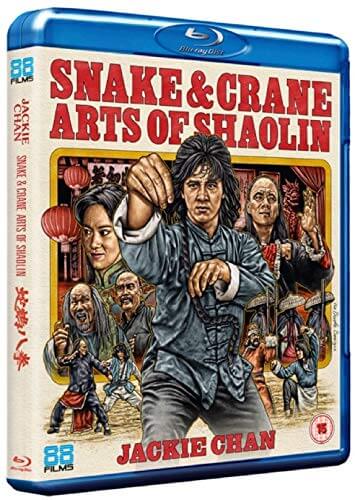
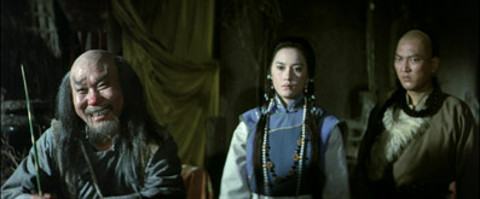
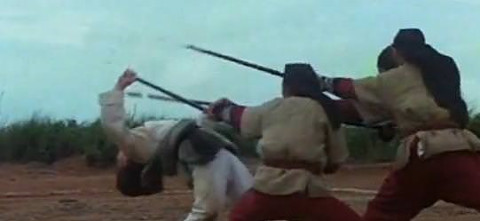

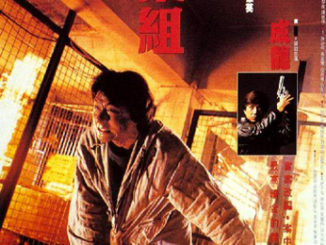
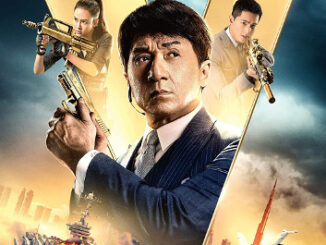
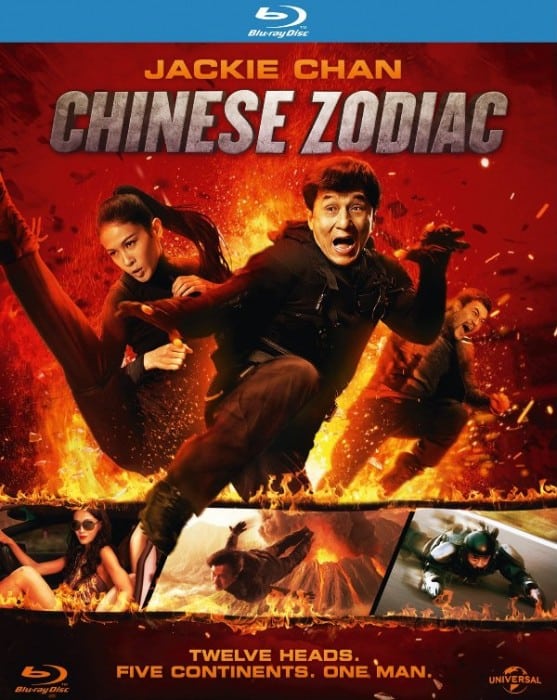
Be the first to comment